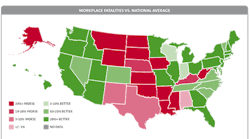Poor Health, Lagging Workplace Safety Have Most Financial Impact in Maryland, Virginia
Employers increasingly are recognizing the impact workplace health and safety management can have on organizational productivity, worker safety and well being, morale, risk management and operational costs.
UL’s Integrated Health & Safety Institute (IHSI) has issued a report ranking the prevalence of health conditions and workplace safety rates in all 50 states compared to the national average. The IHSI report estimates the financial impact of these conditions on a hypothetical company employing 500 workers. The report takes into account the impact of employee absence, increased healthcare costs and lost productivity, and shows trends in the cost of employer provided insurance for each state.
According to UL, the direct and indirect costs of health determinants (diabetes, obesity, smoking, high blood pressure, high cholesterol, strokes, heart disease) and workplace injury and fatality rates were the highest in Maryland. That hypothetical 500-employee company would pay $5,747,360 in total estimated health- and workplace safety-related costs. Virginia, with a total estimated cost of $5,624,136, was second. Rounding out the top 10 are: Connecticut ($5,145,831), Massachusetts ($5,067,558), Minnesota ($5,109,956), New Jersey ($5,010, 363), New York ($5,101,531), North Carolina ($5,182,058), South Carolina ($5,019,602) and West Virginia ($5,026,869).
“The state reports supplement IHSI’s research around the impact of integrating health and safety in the workplace,” said Todd Hohn, IHSI’s global director. “The insights gleaned from these reports provide companies with knowledge to help identify and understand potential issues that, if managed through an integrated health and safety framework, could reduce injuries and illnesses in the workplace.”
Two states tied for lowest direct and indirect costs: Idaho ($4,044,977) and Maine ($4,044,910). The other states with the lowest estimated costs for health determinants and workplace injuries and fatalities included Kansas ($4,379,963), Mississippi ($4,277,955), Nebraska ($4,352,504), New Mexico ($4,288,648), Oregon ($4,396,362), Rhode Island ($4,399,948), Utah ($4,293,350) and Vermont ($4,157,375).
IHSI’s state reports show the cost to employers for providing insurance benefits to their employees as a percent of total compensation dropping in several regions of the country including the eastern, southern and mountain regions in the 2010-2012 time frame.
“While the decrease in the cost of insurance compared to employee compensation was a pleasant surprise, it would be wishful thinking to believe this trend will continue indefinitely,” said Andrew Kapp, IHSI’s research manager. “Furthermore, this figure represents the average for private industry and in state and local government, and individual employers experience varies greatly depending on the employees’ actual use of these benefits.”
Up to this point, available data for companies seeking to understand risk in the communities where they operate has been hard to find and interpret. IHSI is building a strong foundation for companies seeking to find this information. The institute recently sponsored a study, which was published in the January issue of JOEM, that found a correlation between a healthy and safe workforce and a company’s stock market performance. Additionally, UL has published a new standard offering organizations a set of components that should be considered as part of integrated health and safety programming.

